
Soil Associations
0721c WILCOCKS 1
Soil and site characteristics
Slowly permeable seasonally waterlogged fine loamy and fine loamy over clayey upland soils with a peaty surface horizon. Coarse loamy soils affected by groundwater in places. Very acid where not limed.
Geology
Drift from Palaeozoic sandstone mudstone and shale
Cropping and Land Use
Wet moorland habitats of moderate and poor grazing value, some improved grassland; coniferous woodland, military use.
Component soil series
| Subgroup | Series name | Percentage | WRB 2006 link |
|---|---|---|---|
| 7.21 | WILCOCKS | 65% | Umbric Stagnosols |
| 7.21 | KIELDER | 15% | Umbric Stagnosols |
| 8.71 | FORDHAM | 10% | Umbric Gleysols |
Covers 3922 km2 in England and Wales
Soilscapes Classification
| 19 |
Slowly permeable wet very acid upland soils with a peaty surface |
0721c WILCOCKS 1
Detailed Description
The association contains strongly gleyed soils with peaty or humose topsoils. These are the loamy Wilcocks series and the fine loamy over clayey Kielder series (both cambic stagnohumic gley soils) and the coarse loamy Fordham series of the typical humic gley soils. They are seasonally waterlogged, stony soils in greyish drift derived from Carboniferous and Lower Palaeozoic rocks, occurring on gentle to moderate slopes in the Pennines and adjacent upland districts and on the moorlands and in the valleys of upland Wales, between 150 and 600 m O.D. The Wilcocks series has an acid organic surface layer 10 to 40 cm thick, with underlying clay loam or sandy clay loam horizons which are grey and strongly mottled, although the mineral layer immediately below the peat is normally stained with organic matter. The Kielder series is similar but becomes clayey at depth. Unlike these soils, the Fordham series is sandy loam and gleying is not caused by a slowly permeable subsoil but by high groundwater levels. Stone content frequently increases with depth; stones are often sandstones and gritstones but may be shale fragments, or occasionally igneous and other erratics. This association is extensive in Lancashire, Staffordshire and Derbyshire, covering about 465 km² of the Pennines from Leck Fell in Lancashire to Winkhill in Staffordshire. It occurs mainly on drift covered lower slopes and vales adjacent to sandstone escarpments, though it is normally found above 200 m in north Lancashire or 300 m in the Peak District. At these altitudes the cool, wet climate favours the development of peaty topsoils. Although Wilcocks and Kielder soils predominate, there are inclusions of Fordham soils where thick permeable Head has accumulated below sandstone outcrops and some Roddlesworth soils (Clayden and Hollis 1984) occur over clayey till. Rare profiles of the Rhondda (Clayden and Hollis 1984), Belmont, Onecote and Ipstones series are developed locally where the drift thins over sandstone or shale and a few peat soils of the Winter Hill and Hepste series (Clayden and Hollis 1984) are found in hollows, including flush sites. On lower ground the association merges with the Brickfield associations and there are occasional Brickfield soils included. South of Buxton the soils merge into the Onecote association as the drift parent material thins out upslope.
The association is widespread throughout the Pennines and the Northumberland hills, covering 2458 km² . It usually fringes hill peat of the Winter Hill association and merges downslope into the Brickfield association. The dominant Wilcocks series is found where the alternating shales and sandstones contain thick sandstone beds, since the overlying drift is closely related to the solid rock beneath. Where the underlying rock is mostly shale, the clayey Roddlesworth series becomes more common. The fine loamy over clayey Kielder series is extensive in Northumberland. Over large areas these stagnohumic gley soils form a simple soil pattern, becoming locally more complex where the drift thins over rock or where bedrock appears at the surface. The Fordham series is common where thick Head has accumulated below sandstone exposures. Where outcrops of shale are almost drift-free, Ipstones and Onecote series are found. Small patches of peat, usually Winter Hill series, are widespread in wetter places. Minor series include the Belmont, identified by its thin ironpan, the Revidge, and the Rivington which occurs at sandstone outcrops. The association extends from the Pennine footslopes into a drumlin landscape in some districts, with peat soils capping the drumlins and filling the intervening hollows. Where the greyish drift rests on limestone, as in Craven, the substrate is more permeable and stagnopodzols have developed in places. Loamy soils without humose topsoils, Brickfield series, occur locally on steeper drift-covered slopes. Reddish soils occur in a few localities at lower altitudes.
Soil Water Regime
The main soils are severely waterlogged near the surface (Wetness Class V or VI), the wetness being due to a combination of high rainfall, slowly permeable subsoil, gentle relief, and a flow of water from the nearby Winter Hill and Belmont associations. Winter rainwater is not absorbed and runs off rapidly. The soils are not droughty because of their large available water capacity and the low moisture deficits in the districts where they occur.
Cropping and Land Use
Climate is the overriding influence on the use of this land. The effect of relatively low temperatures, high rainfall and low soil moisture deficit, combined with slowly permeable subsoils, causes the inherent wetness of the soils, and particularly the accumulation of organic matter at the surface. On rough grazing the vegetation is dominated by Molinia, Nardus or ling, with cotton-grass and mosses in wetter places. Some land, for example near Onecote and Whaleybridge, has been enclosed and grazing improved. However, if subsequently neglected, it quickly becomes rush infested and ultimately reverts to moorland. In addition to drainage, lime and fertilizers are needed to control the acidity of improved pasture. Surface seeding is the best means of introducing new grass species. Grazing must be carefully controlled following improvement because the soils are easily poached. Extensive sheep rearing is the main enterprise but the more favoured localities provide seasonal grazing for cattle. The Molinia, Nardus and bent-fescue communities are of moderate grazing value but those dominated by heather provide only poor grazing. This is one of the common associations used for forestry because of its poor agricultural value. It forms large parts of forests in the south Wales coalfield, notably Coed y Rhaiadr and adjacent plantations. The main species is Sitka spruce with some Norway spruce.
This is one of the most common associations used for forestry because of its poor agricultural value. It occurs in the large forests near the Scottish border — Kershope, Spadeadam, Fa!stone, Harwood, Wark, Kielder and Redesdale — and in many plantations further south. The main species is Sitka spruce, with some Norway spruce which was favoured before it proved susceptible to exposure. Lodgepole pine has been planted on the worst sites but is not as productive as expected. Scots pine has been planted where sandstone is near the surface and drainage is better, and where some shelter is provided by surrounding trees. Douglas fir and larch have been planted on better drained valley sides, with broadleaf species such as oak and beech for amenity. Some Corsican pine is planted in South Yorkshire where the climate is drier. Deep ploughing is necessary to improve drainage and rooting. Wind damage is least where there is no thinning.
0721c WILCOCKS 1
Distribution Map
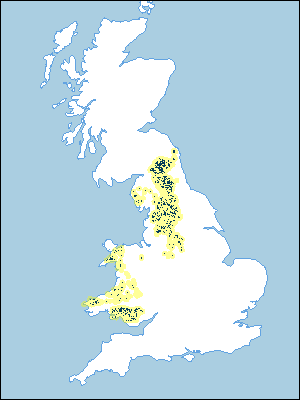 |
Note that the yellow shading represents a buffer to highlight the location of very small areas of the association.
Keys to component soil series
Wales
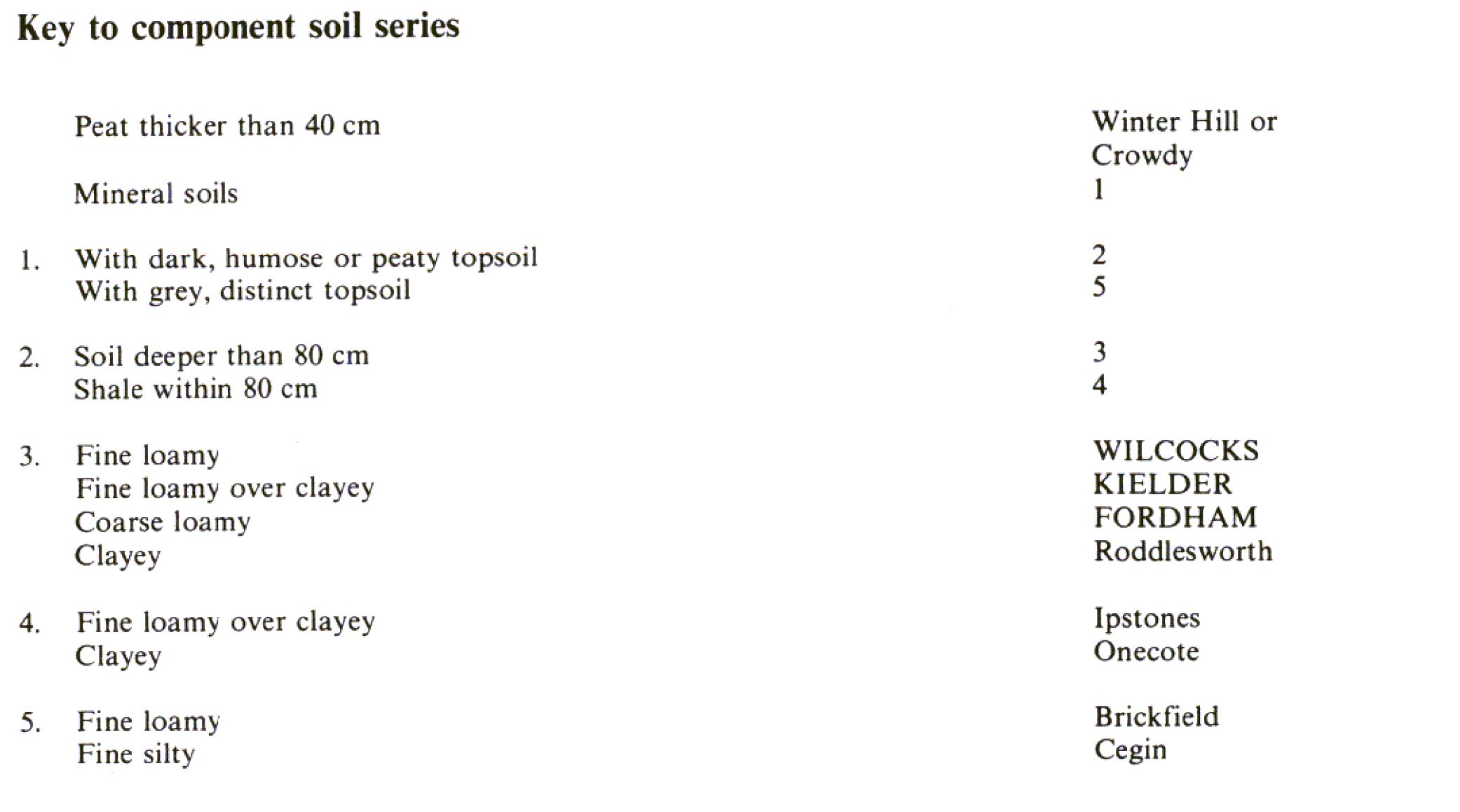 |
Midlands
 |
Northern Region
 |
Typical Landscapes
Wales
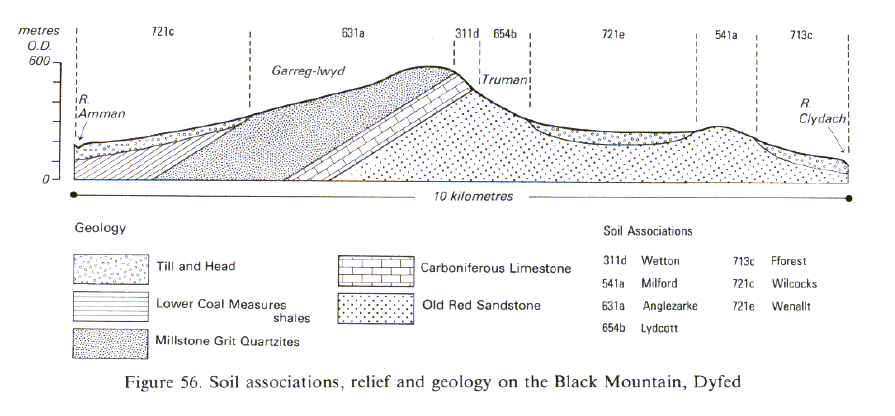 |
Wales
 |
Wales
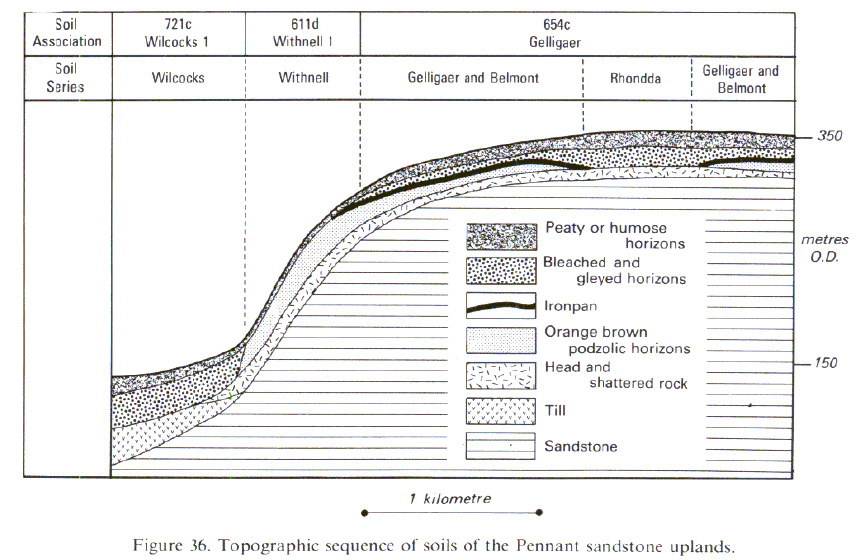 |
Wales
 |
Wales
 |
Northern Region
 |
Northern Region
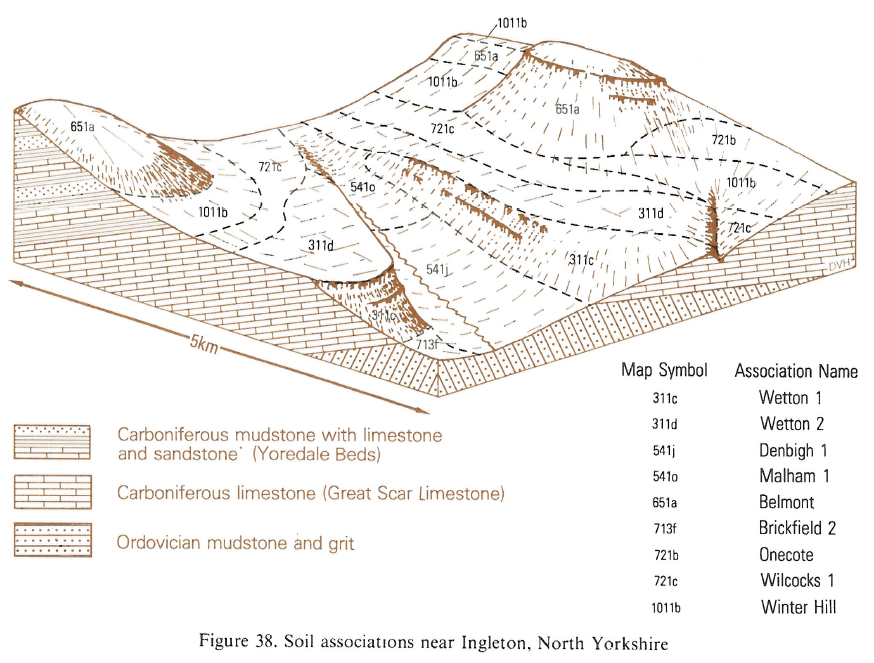 |
Northern Region
 |
All information Copyright, Cranfield University © 2024
Citation: To use information from this web resource in your work, please cite this as follows:
Cranfield University 2024. The Soils Guide. Available: www.landis.org.uk. Cranfield University, UK. Last accessed 25/04/2024
